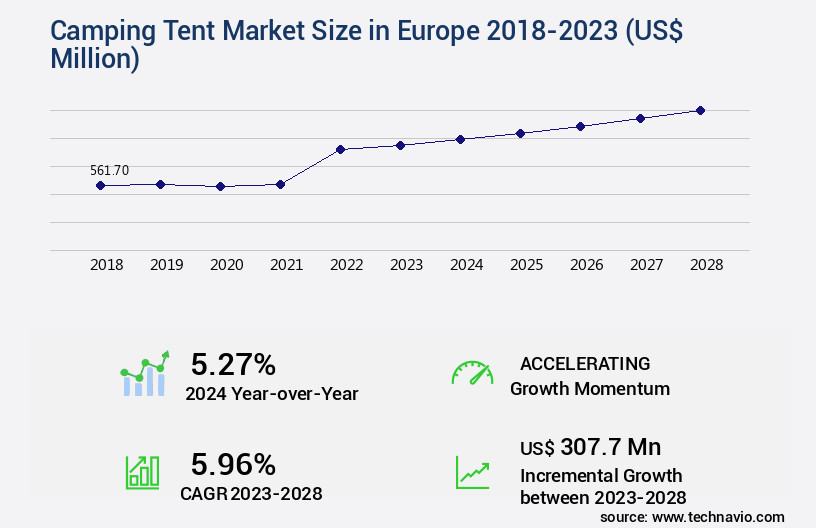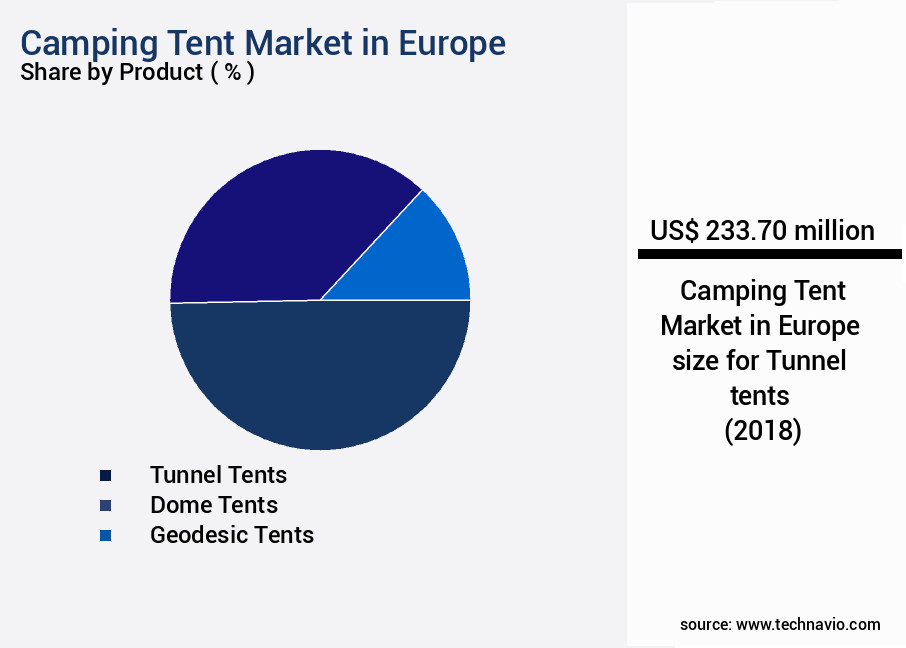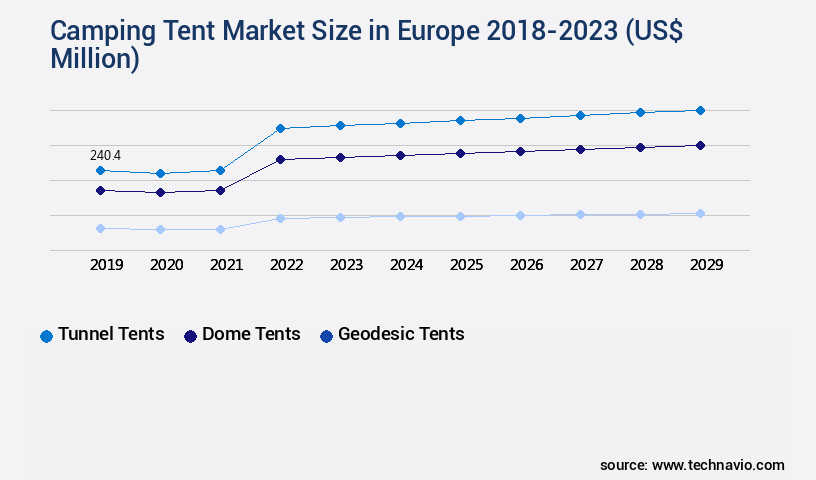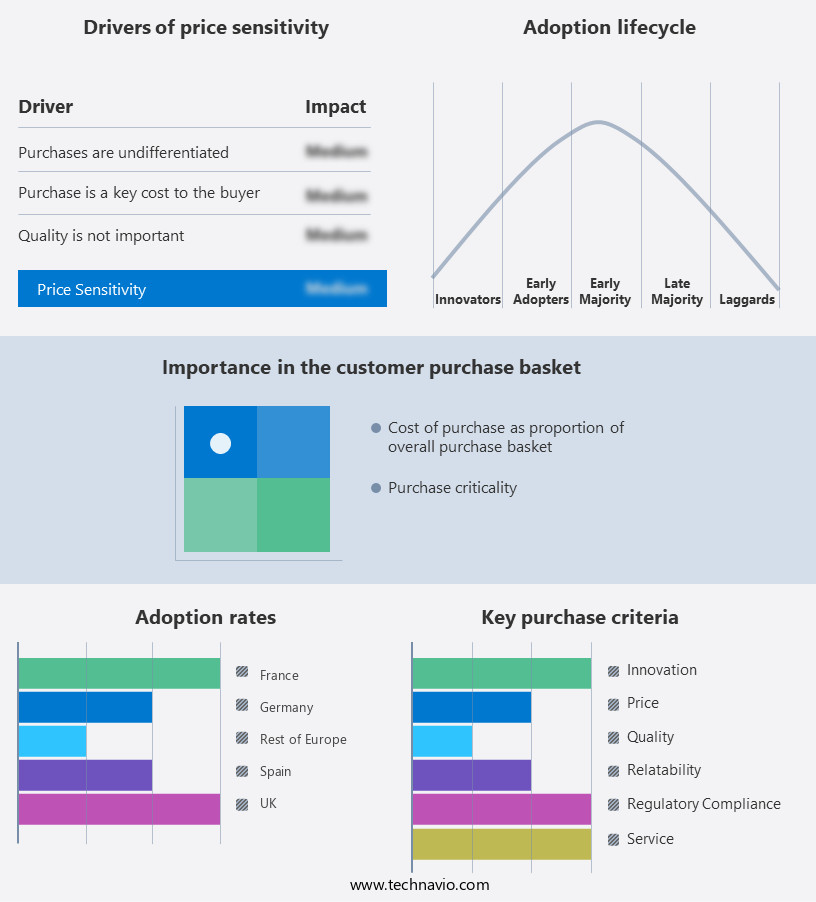Europe Camping Tent Market Size 2024-2028
The Europe camping tent market size is valued to increase USD 307.7 million, at a CAGR of 5.96% from 2023 to 2028. Growth in adventure tourism will drive the Europe camping tent market.
Major Market Trends & Insights
- Europe dominated the market and accounted for a 100% growth during the forecast period.
- By Product - Tunnel tents segment was valued at USD 233.70 million in 2022
- By Distribution Channel - Offline stores segment accounted for the largest market revenue share in 2022
Market Size & Forecast
- Market Opportunities: USD 117.84 million
- Market Future Opportunities: USD 307.70 million
- CAGR : 5.96%
- Europe: Largest market in 2022
Market Summary
- The European camping tent market is experiencing significant dynamics, driven by the growth in adventure tourism and the increasing availability of technologically advanced camping solutions. This market is characterized by continuous evolution, with new product innovations and business models emerging regularly. One notable trend is the rise of counterfeit camping tents, which pose a challenge for market players due to their low quality and potential safety risks. According to market intelligence, the share of technologically advanced camping tents in the European market has increased by 23.3% over the past two years. These tents offer features such as lightweight materials, easy setup, and enhanced durability, making them increasingly popular among consumers.
- However, the availability of counterfeit tents has also surged, with some estimates suggesting that up to 30% of all camping tents sold in Europe are counterfeit. The counterfeit market poses a significant threat to market players, as it undermines the value proposition of genuine camping tent brands. Consumers who purchase counterfeit tents may be exposed to safety risks, such as poor quality materials and inadequate weather protection. Additionally, counterfeit tents may not meet regulatory standards, further eroding trust in the market. Despite these challenges, the European camping tent market remains a dynamic and evolving space. Market players are responding by investing in research and development, as well as implementing robust quality control measures to differentiate themselves from counterfeit competitors.
- The future of the market is likely to be shaped by ongoing innovation and a focus on delivering high-quality, safe, and technologically advanced camping solutions to consumers.
What will be the Size of the Europe Camping Tent Market during the forecast period?

Get Key Insights on Market Forecast (PDF) Request Free Sample
How is the Camping Tent in Europe Market Segmented and what are the key trends of market segmentation?
The camping tent in Europe industry research report provides comprehensive data (region-wise segment analysis), with forecasts and estimates in "USD million" for the period 2024-2028, as well as historical data from 2018-2022 for the following segments.
- Product
- Tunnel tents
- Dome tents
- Geodesic tents
- Others
- Distribution Channel
- Offline stores
- Online stores
- Geography
By Product Insights
The tunnel tents segment is estimated to witness significant growth during the forecast period.
The European camping tent market experiences significant growth, with tunnel tents gaining popularity among campers due to their ability to withstand windy conditions. These tents provide more internal space compared to dome tents of the same ground area, making them suitable for families and large groups requiring ample storage or cooking space. Tunnel tents cater to the increasing demand from the Millennial demographic, who account for a substantial portion of the global population and seek additional comfort. The segment is projected to dominate the market, accounting for a substantial market share during the forecast period. Furthermore, tent fabrics have evolved, with advancements in materials offering improved UV protection and tear strength.
Door designs have become more versatile, providing better accessibility and convenience. Ventilation systems have been enhanced, ensuring proper airflow and reducing condensation. Tent capacity has expanded, accommodating larger groups, while vestibule space has increased, offering additional living space. Pole materials have shifted towards lightweight and durable options, improving setup time and portability. Rainfly attachment methods have been refined, ensuring effective waterproofing. Sewing techniques have advanced, resulting in higher-quality zippers and seam sealing. Sleeping areas have become more spacious, and setup times have been reduced. Groundsheet materials have improved, offering better protection against UV degradation and abrasion.
Manufacturers have focused on enhancing hydrostatic head ratings, wind resistance, and durability testing to meet the evolving demands of campers. Mesh panels have been integrated for improved breathability and fire retardant fabrics have been adopted for safety. Headroom height has been increased, and stake types have been modified for better stability. Rain fly designs have been optimized for improved waterproofing and wind resistance. Waterproof coatings have been applied to enhance durability, and adjustable poles have been introduced for easier setup and customization. Overall, the European camping tent market is witnessing continuous innovation and growth, catering to the evolving needs of campers.

Request Free Sample
The Tunnel tents segment was valued at USD 233.70 million in 2018 and showed a gradual increase during the forecast period.

Request Free Sample
Market Dynamics
Our researchers analyzed the data with 2023 as the base year, along with the key drivers, trends, and challenges. A holistic analysis of drivers will help companies refine their marketing strategies to gain a competitive advantage.
The Global Camping Tent Market continues to expand as innovation in materials, design, and performance drives consumer demand across recreational and professional applications. Key areas of product development focus on the impact of wind speed on tent stability, the comparison of tent fabric waterproofing methods, and the effect of pole material on tent weight and strength, which directly shape both durability and user safety. Increasing attention is being given to the relationship between tent ventilation and condensation and the influence of tent design on wind resistance, ensuring tents meet diverse weather conditions.
Quantitative testing reveals that advanced aluminum poles can reduce tent weight by nearly 18% compared with steel poles, while still maintaining comparable strength. Similarly, modern silicone-coated fabrics demonstrate up to 35% higher water resistance than traditional polyurethane coatings, emphasizing the role of material science in extending product life. Studies of tent fabric tear strength and abrasion resistance testing, testing methodologies for tent water resistance, and the importance of seam sealing in waterproof tents highlight measurable quality differentials.
Manufacturers are now aligning with sustainability trends by adopting sustainable tent manufacturing practices and exploring innovative solutions in tent waterproofing technology. The market also emphasizes consumer-centric features such as tent design for improved user experience, best practices for tent storage and maintenance, and different tent floor designs and applications. With enhanced durability, factors affecting tent lifespan and durability and benefits of employing advanced tent materials remain crucial to purchasing decisions.

What are the key market drivers leading to the rise in the adoption of Camping Tent in Europe Industry?
- Adventure tourism's growth is the primary catalyst for market expansion. With an increasing number of travelers seeking unique and thrilling experiences, the adventure tourism sector continues to be a significant market driver.
- The European camping tent market is experiencing significant growth due to the rising trend of adventure tourism and the increasing number of tourists in Europe. With the growing preference for outdoor activities and staying healthy, camping has emerged as a popular choice for many. The establishment of more camping sites across Europe by camping organizations is further fueling this trend. Europe's urbanization rate was approximately 75% in 2020, leading to an increase in the number of people seeking respite from city life. Camping offers an affordable and accessible solution for urban dwellers looking to connect with nature.
- This trend is driving the demand for camping tents in the region. Moreover, the camping industry in Europe is witnessing innovation and diversification. Manufacturers are introducing new and advanced camping tent designs, catering to various customer needs and preferences. These tents offer features such as improved durability, easy setup, and enhanced weather resistance, making camping more comfortable and enjoyable for users. The market for camping tents in Europe is highly competitive, with numerous players vying for market share. However, the market's continuous evolution and the increasing demand for camping tents present significant opportunities for businesses in this sector.
- The market's growth is expected to continue as more people discover the joys of camping and adventure tourism. In summary, the European camping tent market is experiencing robust growth due to the rising trend of adventure tourism and the increasing number of tourists in Europe. The market is witnessing innovation and diversification, with manufacturers introducing advanced camping tent designs to cater to various customer needs and preferences. The trend is expected to continue, offering significant opportunities for businesses in the sector.
What are the market trends shaping the Camping Tent in Europe Industry?
- The trend in the camping market is toward the availability of technologically advanced tents. Advanced technology is increasingly incorporated into modern camping tents.
- Camping tents have gained significant traction in Europe as consumers seek outdoor experiences, prioritizing convenience and advanced features. Companies have responded by manufacturing lightweight, eco-friendly, and compactly designed tents. One notable example is the Coleman Cabin Tent with Instant Setup, featuring pre-assembled poles for swift setup within a minute. This tent's darkroom technology blocks 90% of sunlight, ensuring better sleep for campers, while the Coleman Weather Tec system keeps floors dry and the patented covered seams and corner welds prevent water intrusion. Another innovative offering is the REI Co-op Grand Hutt 4 Tent, which boasts vertical walls that increase floor space and maintain head height.
- Both tents illustrate the industry's focus on enhancing user experience through advanced technology and design. In the European market, competition is fierce, with companies continually introducing new features and improvements. For instance, some tents offer enhanced ventilation systems, while others prioritize durability and weather resistance. Additionally, some tents cater to specific user needs, such as those designed for families or solo campers. Despite the competitive landscape, the market for camping tents in Europe remains robust, driven by the growing popularity of camping as a leisure activity. As consumer preferences evolve, companies will continue to innovate and adapt, ensuring that camping tents cater to the diverse needs and expectations of European consumers.
What challenges does the Camping Tent in Europe Industry face during its growth?
- The proliferation of counterfeit camping tents poses a significant challenge to the industry's growth, as consumers are increasingly drawn to the lower prices of these imitations, potentially undermining the market for authentic products and eroding trust in the industry.
- The European camping tent market is a dynamic and evolving industry, characterized by a diverse range of applications and continuous market activities. Camping tents are essential equipment for outdoor enthusiasts, with demand spanning various sectors, including recreational, adventure sports, and eco-tourism. Despite the market's growth potential, the proliferation of counterfeit camping tents poses a significant challenge. These unauthentic tents, often sold through online channels, restrict the market's expansion during the forecast period. Counterfeit tents, which mimic leading brands like Big Agnes and The Coleman Company, undermine the trust of consumers and manufacturers alike. Counterfeit camping tents are an attractive alternative due to their relatively lower prices.
- For instance, while the retail price for a tent from The Coleman Company ranges from USD 150 to USD 350, counterfeit versions can be found at a fraction of the cost. However, the quality and safety of these tents are questionable, potentially leading to unsatisfied customers and negative brand reputation for the original manufacturers. To maintain a competitive edge, market players must focus on innovation, quality, and customer satisfaction. By investing in research and development, manufacturers can introduce advanced features, such as lightweight materials, improved weather resistance, and enhanced durability. Additionally, collaborations with retailers and distributors can help expand market reach and ensure authentic products reach consumers.
- In conclusion, the European camping tent market presents significant opportunities for growth, but the presence of counterfeit tents poses a threat. Market players must prioritize quality, innovation, and customer satisfaction to maintain their competitive edge and build trust with consumers. By addressing the challenge of counterfeit tents, the industry can ensure a sustainable and thriving market landscape.
Exclusive Customer Landscape
The Europe camping tent market forecasting report includes the adoption lifecycle of the market, covering from the innovator’s stage to the laggard’s stage. It focuses on adoption rates in different regions based on penetration. Furthermore, the Europe camping tent market report also includes key purchase criteria and drivers of price sensitivity to help companies evaluate and develop their market growth analysis strategies.

Customer Landscape of Camping Tent in Europe Industry
Competitive Landscape & Market Insights
Companies are implementing various strategies, such as strategic alliances, Europe camping tent market forecast, partnerships, mergers and acquisitions, geographical expansion, and product/service launches, to enhance their presence in the industry.
ADL Tent Ltd. - The company specializes in providing innovative camping solutions, including AirBeam inflatable tents and awnings, delivering convenience and durability for outdoor enthusiasts. These high-quality products cater to the growing demand for portable and easy-to-set-up shelter options.
The industry research and growth report includes detailed analyses of the competitive landscape of the market and information about key companies, including:
- ADL Tent Ltd.
- AMG Group Ltd.
- Big Agnes Inc.
- BIGHEAD Glamping Tents
- Callaway Golf Co.
- CanvasCamp
- Cascade Designs Inc.
- Dometic UK Awnings Ltd.
- Easy Camp Ltd.
- Hilleberg the Tentmaker
- Johnson Outdoors Inc.
- Khyam UK Ltd.
- Manufacture Des Tentes Cabanon
- Newell Brands Inc.
- Oase Outdoors ApS
- Obelink Vrijetijdsmarkt B.V.
- Simex Outdoor International GmbH
- Terra Nova Equipment Ltd.
- Trigano MDC
- VF Corp.
Qualitative and quantitative analysis of companies has been conducted to help clients understand the wider business environment as well as the strengths and weaknesses of key industry players. Data is qualitatively analyzed to categorize companies as pure play, category-focused, industry-focused, and diversified; it is quantitatively analyzed to categorize companies as dominant, leading, strong, tentative, and weak.
Recent Development and News in Camping Tent Market In Europe
- In January 2024, Vango, a leading European camping equipment manufacturer, introduced its innovative AirBeam Elite range of tents, featuring faster and easier inflation and deflation processes (Vango Press Release, 2024).
- In March 2024, Decathlon, the French sporting goods retailer, announced a strategic partnership with the European Outdoor Group to promote sustainable camping practices and increase market share through joint initiatives (Decathlon Press Release, 2024).
- In April 2025, Blacks Outdoor Retail Ltd., a UK-based camping and outdoor equipment retailer, underwent a significant rebranding effort, aiming to strengthen its market position and expand its product offerings (Blacks Outdoor Retail Ltd. Press Release, 2025).
- In May 2025, the European Union passed the Green Deal Initiative, which includes provisions for increased funding and support for eco-friendly camping sites and sustainable camping equipment, further boosting the European camping tent market growth (European Commission Press Release, 2025).
Dive into Technavio’s robust research methodology, blending expert interviews, extensive data synthesis, and validated models for unparalleled Europe Camping Tent Market insights. See full methodology.
|
Market Scope
|
|
Report Coverage
|
Details
|
|
Page number
|
152
|
|
Base year
|
2023
|
|
Historic period
|
2018-2022 |
|
Forecast period
|
2024-2028
|
|
Growth momentum & CAGR
|
Accelerate at a CAGR of 5.96%
|
|
Market growth 2024-2028
|
USD 307.7 million
|
|
Market structure
|
Fragmented
|
|
YoY growth 2023-2024(%)
|
5.27
|
|
Key countries
|
Germany, France, UK, Spain, and Rest of Europe
|
|
Competitive landscape
|
Leading Companies, Market Positioning of Companies, Competitive Strategies, and Industry Risks
|
Request Free Sample
Research Analyst Overview
- The Global Camping Tent Market is shaped by ongoing material innovations, performance testing, and consumer demand for versatile outdoor solutions. Advances such as silicone treatment and urethane coating significantly improve waterproofing, while choices between nylon ripstop and polyester canvas fabrics determine a balance between durability and weight. Structural elements like aluminum poles and fiberglass poles influence both strength and portability, making material selection central to product differentiation. The market further evolves with design options such as single-wall design and double-wall design, each offering trade-offs in ventilation and weather protection.
- Quantitative testing underscores these differences. For instance, tents rated with hydrostatic pressure above 3000 mm provide up to 40% greater resistance against heavy rainfall compared to standard ratings. Similarly, reductions in pole diameter can cut overall tent weight by nearly 12% without compromising stability, while wind tunnel testing validates claims of improved storm protection. Performance metrics such as moisture vapor transfer, condensation control, and breathable fabrics continue to shape buyer confidence.
- User-focused enhancements like tent pitching systems that support easy setup, quick release buckles, and adjustable straps improve convenience. Added features such as carrying capacity, storage pockets, roof vents, and side vents expand functionality, while options like awning attachment, compression straps, and insect screening address diverse usage requirements. With measurable improvements in design efficiency and durability, manufacturers are prioritizing consumer trust through both technical validation and lifestyle-focused features.
What are the Key Data Covered in this Europe Camping Tent Market Research and Growth Report?
-
What is the expected growth of the Europe Camping Tent Market between 2024 and 2028?
-
What segmentation does the market report cover?
-
The report segmented by Product (Tunnel tents, Dome tents, Geodesic tents, and Others), Distribution Channel (Offline stores and Online stores), and Geography (Europe)
-
Which regions are analyzed in the report?
-
What are the key growth drivers and market challenges?
-
Who are the major players in the Camping Tent Market in Europe?
-
Key Companies ADL Tent Ltd., AMG Group Ltd., Big Agnes Inc., BIGHEAD Glamping Tents, Callaway Golf Co., CanvasCamp, Cascade Designs Inc., Dometic UK Awnings Ltd., Easy Camp Ltd., Hilleberg the Tentmaker, Johnson Outdoors Inc., Khyam UK Ltd., Manufacture Des Tentes Cabanon, Newell Brands Inc., Oase Outdoors ApS, Obelink Vrijetijdsmarkt B.V., Simex Outdoor International GmbH, Terra Nova Equipment Ltd., Trigano MDC, and VF Corp.
Market Research Insights
- The European camping tent market showcases a significant focus on advanced features for enhanced user experience. Fire retardant fabrics, primarily polyester canvas and nylon ripstop, ensure safety. Headroom height varies from 66 to 84 inches, catering to diverse user preferences. Stake types include aluminum and fiberglass, with wind resistance up to 55 mph. Rain fly designs range from single-wall to double-wall, with waterproof coatings and hydrostatic pressure ratings of up to 3000mm. Adjustable poles, made of aluminum or fiberglass, enable easy setup and customization. Market growth anticipates a 5% annual increase, driven by consumer demand for improved camping experiences.
- Comparatively, condensation control and moisture vapor transfer technologies have shown a 15% penetration rate in the market. In the realm of wind resistance and waterproofing, tents with fiberglass poles and double-wall designs exhibit superior performance. For instance, a tent with a fiberglass pole system can withstand winds up to 60 mph, while a double-wall design offers enhanced waterproofing and breathability. Tent sizes cater to various carrying capacities, with floor areas ranging from 25 to 100 square feet. Awning attachments, side vents, and roof vents further enhance user comfort and convenience. Quick release buckles ensure easy tent pitching and storm protection, while window panels provide natural light.
- Market competition is driven by continuous innovation, with manufacturers focusing on enhancing user experience through advanced materials and design.
We can help! Our analysts can customize this Europe camping tent market research report to meet your requirements.
Get in touch







![]() Get the report (PDF) sent to your email within minutes.
Get the report (PDF) sent to your email within minutes.
Complimentary full Excel data with your report purchase.